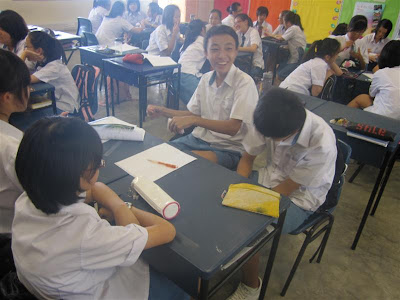14 April 2010
CT3 Full marks students
Boey Lye Weng
Lena Ch'ng
Elicia Lim
Neo Ming Hoon
Jolynn Tan
Dylan Tan
Ong Soon Heng
Suman Chapagain
Congrats!
Unfortunately, there is 1 student who fail the test.
13 April 2010
01 March 2010
Shifting Cultivation
The Kantu Tribe
WHAT IS SHIFTING CULTIVATION?
Shifting cultivation is a farming method. A common form of this method is known as slash-and-burn farming. The way of burning is in order of:
1. Burning of trees for plots of land to plant and grow crops or to build settlements on.
2. Ash left on the land is used as a fertilliser for the crops.
3. Land is used for farming up to 3-4 years until it becomes infertile. (UNLESS CROP ROTATION IS DONE)
4. The shifting cultivators therefore move to another part of land for farming and start all over again.
An example of a shifting cultivator is the Kantu Tribe.
Shifting cultivators uses fire to clear forests as it is quick, cheap and not labour intensive this enables farmers to clear large plots of land & the ash left from the fire can be used as fertilizer for the crops grown.
Pros of shifting cultivation:
i. Its reduces the amount of pest in the plots of land and is often a form of pest-control.
ii. It also clears the weeds, therefore crops grow quickly.
Cons of shifting cultivation:
· When it burns down trees, soot is released into the air and it causes air pollution in which can lead to further problems like acid rain and global warming.
It causes deforestation by the cutting down of trees. The trees can no longer hold down the soil so everything flows into the river, therefore, deforestation and soil erosion is caused.
- Shifting Cultivation is often practiced by primitive tribes in the forested highlands of the Amazon Basin, Congo Basin, etc.
THE ADVANTAGES
MORE INFORMATION
This system often involves clearing of a piece of land followed by several years of wood harvesting or farming until the soil becomes infertile.
Once the land becomes infertile for crop production, it is left to be reclaimed by natural vegetation, or sometimes converted to a different long term cyclical farming practice (EXAMPLE CROP ROTATION).
An estimated population exceeding 250 million people derive subsistence from the practice of shifting cultivation, and ecological consequences are often deleterious..
METHODS
 - Slash and burn
- Slash and burn
**EXTRA** - Taken From http://www.ias.ac.in/currsci/jan102009/10.pdf
..It is because shifting cultivation has its own merits in the sense that fallowing of land helps in conservation of soil moisture, enrichmentof soil texture and soil structure, addition of potassium to the soil during the process of burning, increase in soil pH, increase in soil microbial biomass, restriction in outgrowth of particular pests and pathogens for particular crops. Least disturbance of top soil, development of a good crop canopy due to mixed cropping, no capital investment except labour and seeds which usually come from the household and above all, the outcome of organically economic produce – free from hazards of synthetic fertilizers/ pesticides, herbicides..

- Controlled burn
Controlled burning stimulates the germination of some desirable forest trees, thus renewing the forest.
Some seeds, such as sequoia, remain dormant until fire breaks down the seed coating.
24 February 2010
23 February 2010
Oil palm plantation is also able to give better food, therefore, people will be more healthy and grow to a ripe old age.
Udon Thani BY CECILIA’s group:
Nowdays, advanced technology is improving our lives but at the same time, it causes harm to our health. But the wet rice cultivation do not cause harm to the environments.
Examples are:
(1)Chemicals and harmful substances were not used to grow crops. Which means it will not pollutes the air.
(2)There were no heavy use of fertilisers and pesticides unlike other intensively cultivated rice fields.
(3)Wildlife will be able to adapt to the surroundings and will not become extinct as the people living there made little changes to the surroundings only.
(4) The food is clean and free of chemicals or other substances and does not harm our health.
(5)There will be no air pollution.
Why?
(1)Chemicals and harmful substances were not used to grow crops. Which means it will not pollutes the air.
If we breathe in too much of the polluted air caused by chemicals and harmful substances, the harmful substances get in our lungs and causes disease in later part of our life. It will also result in air pollution (why? ~produced by the chemicals and harmful substances) and global warming (why? ~air pollution will soon lead to global warming).
(2) There were no heavy use of fertilisers and pesticides unlike other intensively cultivated rice fields.
There were no signs of modernisation and irrigation except for some wells and ponds. This means everything there is grown naturally. It will not cause air or water pollution (no advanced machines or harmful chemicals thus there will not be any pollution) or extinction of native fauna and flora (since there is no destruction on their habitats).
(3)Wildlife will be able to adapt to the surroundings and will not become extinct as the people living there made little changes to the surroundings only.
The people living there adapt to the physical environment and made little changes to it. There were no signs of modernisation and irrigation except for some wells and ponds. This shows that people in Udon Thani live a simple life and do not really cause much destruction to the environment.
(4) The food is clean and free of chemicals or other substances and does not harm our health.
The crops they plant were controlled by the natural weather, they have fertile and flat soil to allow large plantation to be carried out and the crops have the natural vitamins and nutrients which is clean and does not harm our health. The crops do not consist of chemicals and harmful substances.
(5)There will be no air pollution.
There will be no air pollution as the farmers did not use machines such as seeders, harvester nor tractor to farm and the water is clean.
Conclusion: Wet rice cultivation will definitely be the best agricultural practice for the environment as it benefits the health of humans. It will not cause environmental degradation but it definitely will not cause world hunger provided if everyone practises wet rice cultivation. I am sure that the crops grown by wet rice cultivation will have a lot of nutrition.
Best for environments: Does not cause pollution or major destruction.
Public Health: Nutritional, healthy and free of chemicals.
Done by: Mun Yu, Melia, Hazel, Xue Ting, Cai Ying, Jolynn, Carissa, Ernest and Dylan
22 February 2010
Agro-Techonology Group
In short, agro- technology farming allows us to maximize the profit and minimize the cost. Agro-technology farming ensures that the soil is fertile so that the crops could grow healthily. It does not involve deforestation and does not contribute much to global warming. In addition, this kind of agriculture could increase the total number of crops produced and at the same ensuring that the crops is more nutritional. It is impossible to get diseases from the farm animals that were sold farms as they were vaccinated to make sure that they are safe to consume. Many requirements such as water, sunlight and etc. could be controlled in this agriculture so as to allow the plant to grow better.
Thus, this kind of farming promises products which is healthier and produces crops and animals which is safe to consume. It is considered environmental friendly and ensures that highest profit could be made with the lowest possible cost. This kind of farming can actually attract tourism which is yet another benefit. Therefore, agro-technology farming is the best way among all the farming method.
--Soon Heng's group
18 February 2010
10 February 2010
Best Alternative Assignment
2HUM Best AA
By Shirnise and Xin Er
Shirnise & Xin Er
By Elicia and Belicia
Elicia & Belicia
08 February 2010
Agriculture Assignment Groups
Lye Weng
Jasmine
Jazz
Patricia
Yujia
Reynoso
CHRISTIAN
Merwyn
Xing Er
Gladys
Udon Thani
CECILIA
Mun Yu
Hazel
Xue Ting
Cai Ying
Jolyn
Ernest
Dylan
Carissa
Melia
Oil Palm Plantation in Malaysia
Vanessa
Sheryl
TAN YING
Charmaine
Belicia
Lena
Theresa
Suman
Wee Teck
Yifan
Agro-Technology Farming in Singapore
Janice
Elicia
Nian Yao
Ming Hoon
Shirnise
Xiao Ling
Zhang Quan
SOON HENG
Sidhant
*Leaders are those in BOLD

















